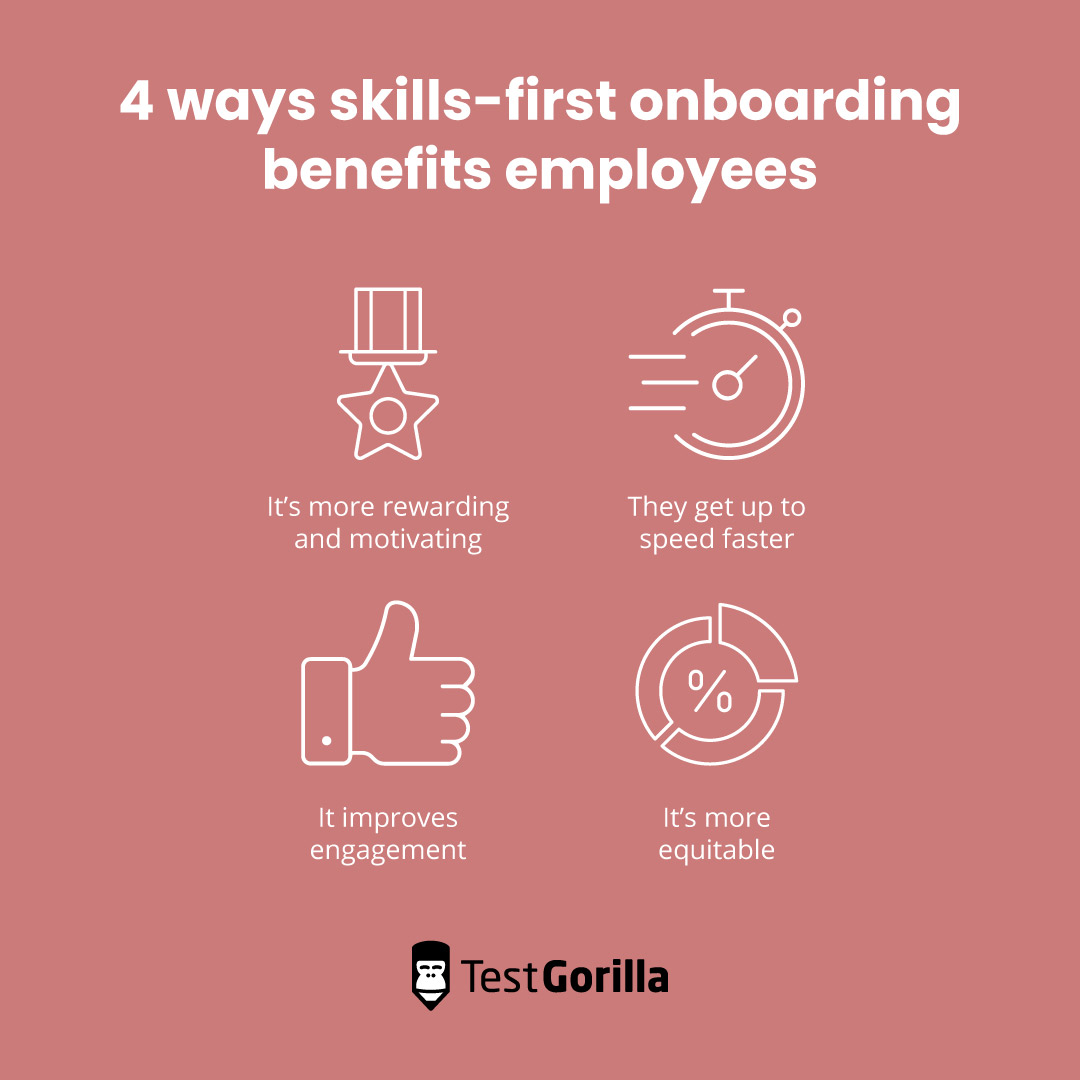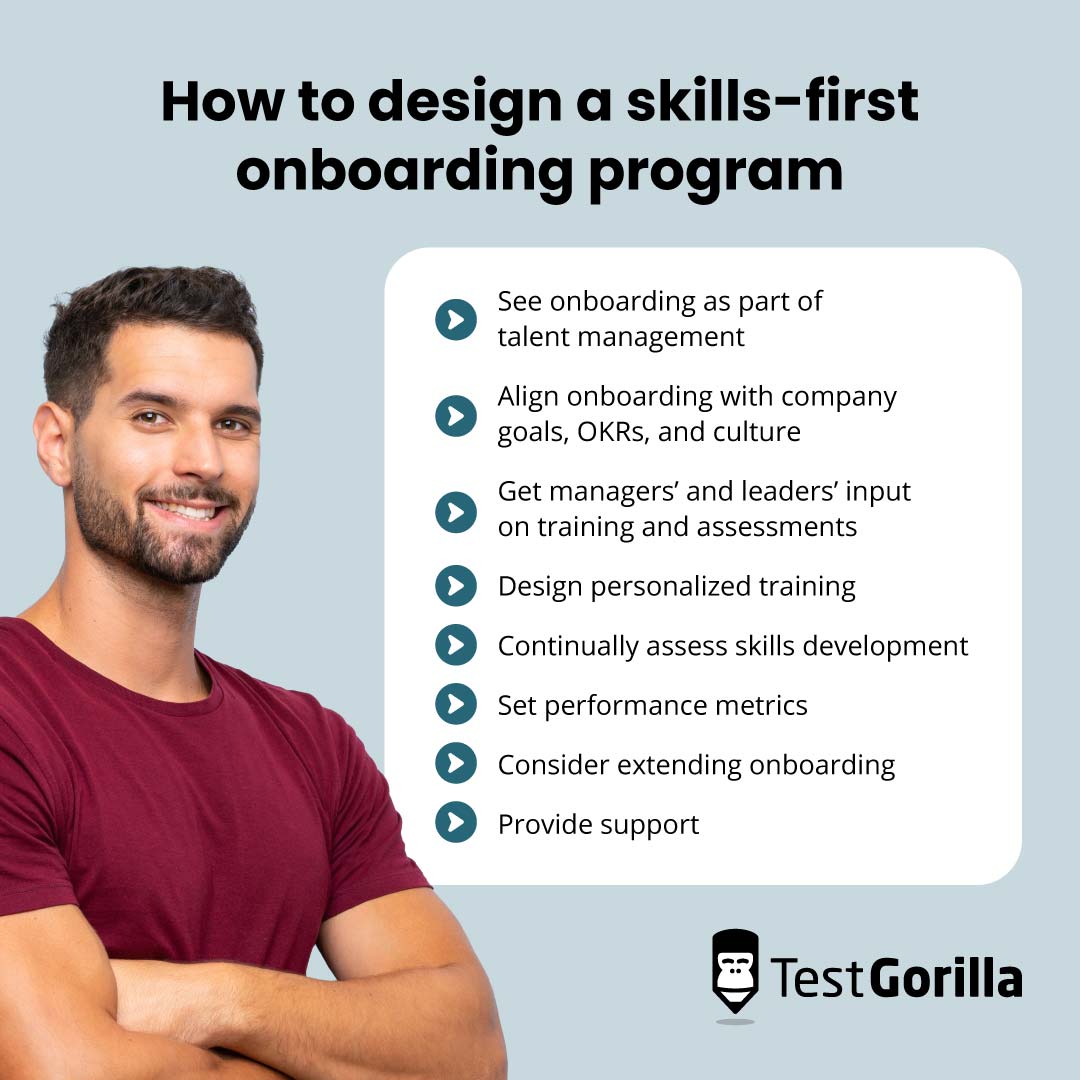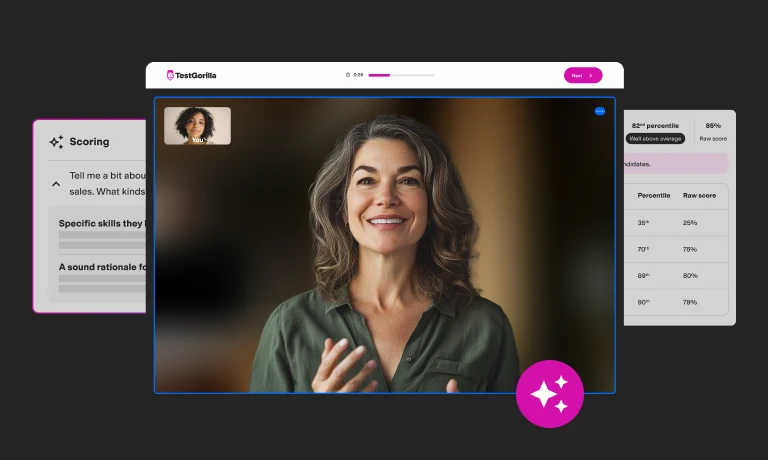Thirty percent of people quit a new job within the first three months.[1] This is a huge waste of hiring resources, especially as it can cost $4,683-$28,329 to fill those gaps in your workforce.[2]
This means a new employee’s initial experience with your company is crucial for retention.
Effective onboarding programs can make a big difference to employee productivity and their sense of belonging. Yet many companies still cram onboarding into a few days or weeks and focus only on the practical aspects like setting people up with a workspace, an email account, and a batch.
This can be frustrating for new employees and leave them feeling unfulfilled or struggling in those key early days. It also doesn’t take full advantage of the skills you hired them for, which they’ll be keen to start developing from day one.
In this article, we’ll look at how making skills development a key focus of your onboarding strategy can help new employees feel more satisfied, engaged, and in it for the long haul.
We’ll also explore best practices such as integrating onboarding into your overall talent management strategy and extending the training period to anything from 90 days to one year. All of this with the support of managers, peers, and team leaders, of course.
Why you need to rethink onboarding
Your job as an HR professional isn’t done after a candidate accepts your offer. You then need to ensure their smooth transition to their new team and responsibilities – and that they can make the most of their skills.
An onboarding checklist makes it easier to integrate your new employee into the company, as it ensures nothing slips through the cracks. However, there’s more you can do to take advantage of their skills from the get-go.
By rethinking your induction and orientation process and adopting a skills-first onboarding approach, you can:
Guarantee everyone gets equal support and opportunities during their first weeks and months
Make all managers equally responsible for employee success during onboarding
Potentially reduce your turnover rate during the first 90 days
What is skills-first onboarding?
Skills-first onboarding involves training employees based on the specific abilities they need to excel at a role.
Along with a clear skills-centered job progression track, skills-first onboarding gives new recruits visibility on what’s expected in the short, mid, and long term.
If you’re using skills-based hiring rather than relying on outdated resumes, you can access data from talent assessments to identify skills gaps and needs. Then, you can come up with a personalized coaching or training plan to help new hires develop skills on the job.
For example, let’s say you hired a project manager who passed all of your core skills tests but needs to strengthen their skills within a specific project management software. During onboarding, you can use that information to tailor your learning plan. In this instance, rather than explaining the basics of what a Kanban board is, you could get straight into more complex aspects of multi-calendar scheduling.
As well as being more useful for your company, this makes for a better employee experience. Let’s take a look at why in more detail.
How skills-first onboarding benefits employees
Skills-first onboarding tells employees, from the very beginning, that you care about strengthening their abilities and helping them close skills gaps integral to their success.
This approach is beneficial for newcomers because:
It’s more rewarding and motivating. You get to personalize or fast-track the learning experience using talent assessment data, which shows that you care about their time and value their knowledge.
They get up to speed faster. Training people to close skills gaps rather than boring them with information they already know means they can start being productive and delivering value early on.
It improves engagement. Investing in their professional development and showing a clear career progression track gives people more clarity on role expectations, which boosts happiness.[3]
It’s more equitable. Focusing on skills during hiring, onboarding, and promotion sends a message that you won’t be promoting or favoring one person over another because of superfluous factors like their background or ability to network.
How skills-first onboarding benefits organizations
Skills-first onboarding can save you money because you retain people for longer, which improves recruitment ROI.
Here are other ways it benefits your company:
Improves retention. When people have a clear career progression and know from the very beginning what’s expected of them to reach the next level, they’re more likely to stay at the company.[3]
You can invest more in improving the employee experience. If you don’t lose people during the first few weeks, you can use the money you would have spent hiring someone else to train managers, offer bonuses, or establish a recognition program to reward and retain talent.[4]
Increases productivity. People can get up to speed faster with personalized training, allowing you to get value from them in less time.[5]
Taking a skills-based approach to hiring from the outset also:
Widens your talent pool. Hiring and onboarding with a focus on skills make you more attractive to top talent, including those skilled through alternative routes (STARs) who may not have followed traditional education pathways.
Helps you make better decisions. A skills-based approach gives you access to more precise data which makes it easier to update and improve in the future and make employee-facing decisions. According to our 2022 State of Skills-Based Hiring report, companies that use skills-based hiring see a 92.7% reduction in mis-hires and an 89.8% reduction in overall cost-to-hire.
The best insights on HR and recruitment, delivered to your inbox.
Biweekly updates. No spam. Unsubscribe any time.
How to design a skills-first onboarding program
There are many different ways to put together a skills-first onboarding program. However, it’ll be more successful if you make it part of talent management and get managers and leaders’ buy-in.
Let’s take a look at how to do this in eight simple steps:
1. See onboarding as part of talent management
Before implementing skills-first onboarding, you need to define exactly what the skills required for each role are.
Kelly Robinson, chief executive officer and founder of PKRecruiting, advises evaluating “each person’s and role’s skills gaps and define the educational pieces you need to create for each position.”
This should result in specific skills maps per role, level, and department. This way, your employees will know exactly what’s expected of them to exceed in their current role, reach the next level, or even make a lateral move.
This skills map should fit with your other talent management practices, allowing you to implement a skills-based approach throughout the employee lifecycle. This lets you hire, onboard, develop, and evaluate your employees with an eye on hard and soft skills.
2. Align onboarding with company goals, OKRs, and culture
Onboarding should have clear objectives for each employee and its goals should speak directly to the company objectives and key results (OKRs).
For example, if one of your objectives is to reduce employee turnover during the first 90 days by 2%, some of your key results might be:
Come up with a 30-, 60-, and 90-day onboarding plan
Get 49 out of 50 new hires to complete 90% of the 90-day plan
Ask for employee feedback and iterate on the onboarding plan until you get an average score of 4.5 out of 5 in internal surveys
Using those larger goals, you can come up with role-specific OKRs for onboarding. For example, you might request each employee to reach >90% completion during the first three months.
Want to dive deeper into employee onboarding?
Read our complete guide. It’s packed with tips, step-by-step strategies, and industry insights —to build a seamless employee onboarding plan.
3. Get managers’ and leaders’ input on training and assessments
A crucial part of onboarding is getting buy-in from leaders and managers since these are the people who really understand what an employee will need to do on the job.
One way to get managers involved is by asking for their input when designing the onboarding plan. Invite them to design training modules and assessments based on real-life examples. This helps ensure new employees can get up to speed with practical, skills-based training.
“The manager has to be on board with the qualifications that were designed for that role,” Kelly says. “They need to know what skills you’re looking for and which training they’ll be attending.” This fosters alignment and means managers will be more likely to encourage new hires to attend onboarding sessions because they know they’ll learn things that will positively impact the team.
4. Design personalized training
Tailor your onboarding using the results from the talent assessments you ran during hiring. Then, assign specific modules per role, department, and proficiency level to train your employees on new skills and strengthen core competencies.
You can get as creative as you want and include hands-on training or even experiential learning through simulations.
During this step, you should also take into account your new hire’s learning style as well as your training resources. You might need to have a mix of live or in-person training with computer-based and self-paced modules.
5. Continually assess skills development
Your onboarding plan must guarantee that employees are actually improving their skill levels, so don’t focus on classroom training alone. Include practical training sessions during your 30-, 60-, and 90-day plan to ensure people can continually put their skills to the test.
To test if your team is actually improving their hard and soft skills, use automated talent assessments from TestGorilla’s test library to measure their level of proficiency. Assess skills before (during hiring or prior to an internal move), during, and after onboarding.
After onboarding is over, you can still run regular talent assessments during their first year or at times of change to get an idea of how they’re progressing.
6. Set performance metrics
As well as checking if your new hires are learning, you should evaluate how onboarding impacts performance. To do so, set performance metrics that are tied to the skills in each individual’s onboarding plan.
“You have to measure the onboarding plan ongoing. You need to know what’s actually working and what the gaps are.” – Kelly Robinson, chief executive officer and founder of PKRecruiting.
Setting performance metrics allows you to know if your onboarding plan is actually impacting results and skills development. This gives you insights into whether or not the skills you’re focusing on are the right ones, as well as whether you need to adjust your onboarding plan.
“Get feedback from the new hires that are trying the plan out and from their managers,” Kelly says. “You need to discover what it’s missing.”
7. Consider extending onboarding
Some experts recommend at least 30 to 90 days of formal onboarding.[6] Others believe it can take up to a year for new employees to get ramped up and learn all the skills they need for the role and perform at a high level.[7]
Either way, companies that offer a good onboarding experience can see an improvement in retention by 82%.[8]
Thinking of onboarding as a year-long program with more focused training during the first three months can provide a better employee experience.
For example, you can tie onboarding to learning and development plans. During the first few months, you set new hires with specific onboarding tasks. Then, you can invite them to complete complementary training modules after three, six, nine, and 12 months.
Setting a year-long learning and development plan will also be easier when you’ve mapped the required skills per role and the required proficiency per level.
8. Provide support
While your new employee is responsible for successfully completing their onboarding, it never hurts to do it with the support of others. This includes their managers, peers, mentors, coaches, or work buddies.
Involving various people and making them accountable for employee onboarding could also help keep new hires engaged through onboarding and beyond. Having work friends is known to have a positive impact on long-term retention and engagement, which is why many have established “work buddy” programs.
Google, Spotify, Meta (formerly Facebook), Buffer, Netflix, and Trello all run buddy schemes. This involves assigning an existing employee to help the newbie out and answer any questions they might have. It works because newly hired employees may feel more comfortable asking simple questions like “How long is the lunch break?” to peers rather than managers.
If you’re implementing a buddy scheme in your business, make sure you have the buddy’s agreement before assigning them to support a new employee. Not everyone will be willing or suitable, so the program works best when both parties are engaged and, ideally, have some things in common.
Skills-first onboarding: The key to maximizing recruitment ROI
With around a third of employees quitting in the first three months, the start of their journey is key to their long-term success and chances of sticking around.[1]
Viewing onboarding as an administrative task or “an HR thing” and thinking you only need to set them up with an email account and a laptop just won’t cut it for today’s top talent. In fact, this approach often leaves employees feeling lost and isolated, despite their enthusiasm to make contributions from day one.
To reduce turnover rates, save money on rehiring, and engage employees from day one, shift toward a skills-first onboarding approach. This allows you to create clear career progression expectations, personalized learning experiences, and an effective support structure. To do all this, you also need to set specific performance metrics, link results to company-wide OKRs, and measure employee progress using talent assessments.
To ensure the best results, make skills-first onboarding part of your talent management strategy. Then, invite your new hires to complete talent assessments during recruitment and during and after onboarding to determine the success of your plan. You can use this data to make changes to the onboarding process, decide on individual career paths, and train your employees to keep growing.
Start developing your new hire’s skills from the word go. Talent assessments give you hard data on employees’ proficiency in role-specific skills. |
Sources:
“2022 Job Seeker Nation Report: Dynamic Motivations of Modern Workers” (2022) Retrieved on August 29th, 2023. https://web.jobvite.com/rs/328-BQS-080/images/2022-12-2022JobSeekerNationReport.pdf
“SHRM HR Benchmarking Reports Launch as a Free Member-Exclusive Benefit” (2022) Retrieved on August 29th, 2023. https://www.shrm.org/resourcesandtools/hr-topics/benefits/pages/shrm-hr-benchmarking-reports-launch-as-a-member-exclusive-benefit.aspx.
“State of the Global Workplace: 2023 Report” (2023). Retrieved on August 30th, 2023. https://www.gallup.com/workplace/349484/state-of-the-global-workplace.aspx
“Factors Influencing Attrition and Retention: An Empirical Analysis in a Textile Industry” (2023). Retrieved on August 30th, 2023. http://jairjp.com/VOLUME%2011%20ISSUE%203%20FEBRUARY%202023%20TO%20MAY%202023/05%20HARINI%20RESEARCH%20ARTICLE-JAIR.pdf
“Putting Skills First: A Framework for Action” (2023). Retrieved on August 30th, 2023. https://www.pwc.com/gx/en/issues/upskilling/first-skills-report/report/WEF_CNES_Putting_Skills_First.pdf
“Q&A: 30-60-90 days Onboarding plans with Vaasavi Suncol” (2023). Retrieved on August 30th, 2023. https://newsletter.hrbrainpickings.com/p/30-60-90-day-plan
“Is there a minimum amount of time you need to stay at a job?” (2021). Retrieved on August 30th, 2023. https://www.bbc.com/worklife/article/20211206-is-there-a-minimum-amount-of-time-you-need-to-stay-at-a-job
“The True Cost of a Bad Hire” (2015). Retrieved on August 30th, 2023. https://b2b-assets.glassdoor.com/the-true-cost-of-a-bad-hire.pdf
Related posts
You've scrolled this far
Why not try TestGorilla for free, and see what happens when you put skills first.






















